Mergers and Acquisition Impact on Chinese E-Commerce
VerifiedAdded on 2019/11/20
|33
|7974
|191
Literature Review
AI Summary
This literature review examines the impact of mergers and acquisitions (M&A) on the value of Chinese e-commerce firms. It explores the background of the global and Chinese e-commerce industries, the economic value associated with M&A, and the adoption of M&A in various industries. The review also discusses the impact of M&A on business values, including successful cross-border market entry, research and development, administrative benefits, enhanced market share, operational cost optimization, financial leverage, and shared technology. Furthermore, it addresses issues associated with M&A, such as ignorance of crucial business points, lack of common vision, team resourcing, poor governance, hidden costs, and poor communication. The review concludes with effective ways to improve M&A in the e-commerce industry, including detailed due diligence, careful integration planning, clear communication, prompt action, right consideration of M&A candidates, commitment to one culture, and consistent monitoring of business performance. The conceptual framework highlights the relationship between M&A and organizational value, emphasizing the importance of resource management, stakeholder management, financial leverage, and research and development. The review also identifies a gap in the literature regarding the analysis of financial values of e-commerce companies through M&A, which this research aims to address.
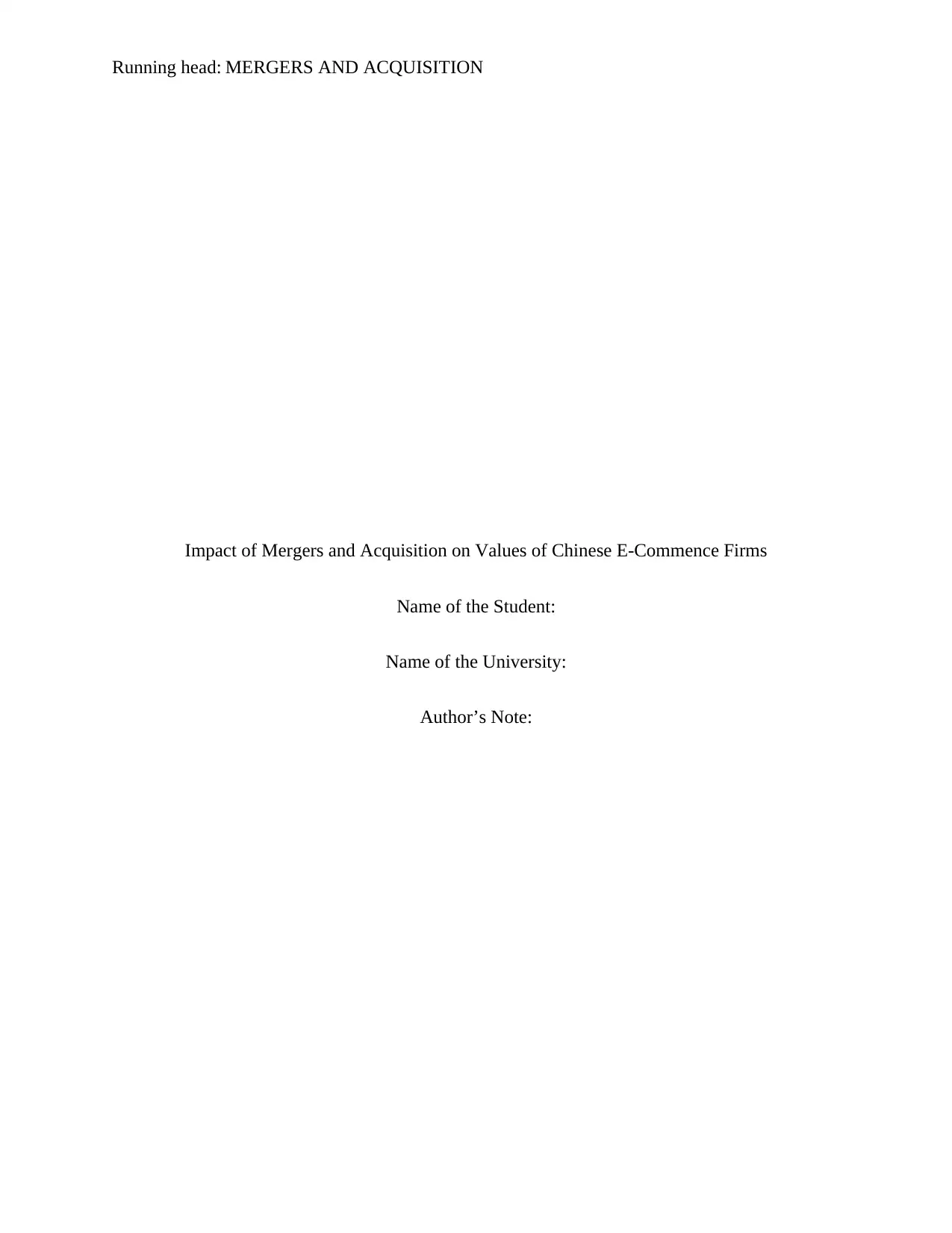
Running head: MERGERS AND ACQUISITION
Impact of Mergers and Acquisition on Values of Chinese E-Commence Firms
Name of the Student:
Name of the University:
Author’s Note:
Impact of Mergers and Acquisition on Values of Chinese E-Commence Firms
Name of the Student:
Name of the University:
Author’s Note:
Paraphrase This Document
Need a fresh take? Get an instant paraphrase of this document with our AI Paraphraser
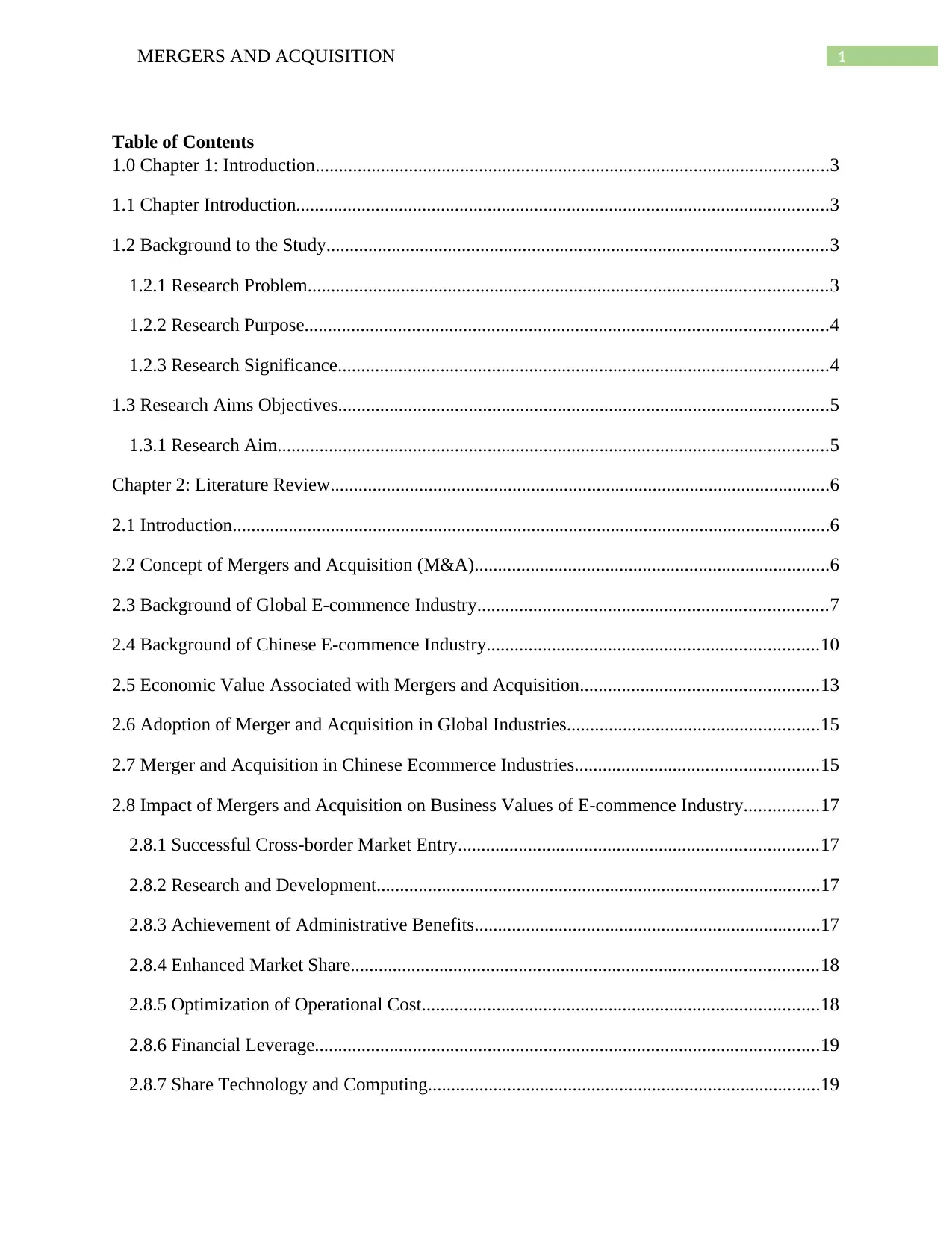
1MERGERS AND ACQUISITION
Table of Contents
1.0 Chapter 1: Introduction..............................................................................................................3
1.1 Chapter Introduction..................................................................................................................3
1.2 Background to the Study...........................................................................................................3
1.2.1 Research Problem...............................................................................................................3
1.2.2 Research Purpose................................................................................................................4
1.2.3 Research Significance.........................................................................................................4
1.3 Research Aims Objectives.........................................................................................................5
1.3.1 Research Aim......................................................................................................................5
Chapter 2: Literature Review...........................................................................................................6
2.1 Introduction................................................................................................................................6
2.2 Concept of Mergers and Acquisition (M&A)............................................................................6
2.3 Background of Global E-commence Industry...........................................................................7
2.4 Background of Chinese E-commence Industry.......................................................................10
2.5 Economic Value Associated with Mergers and Acquisition...................................................13
2.6 Adoption of Merger and Acquisition in Global Industries......................................................15
2.7 Merger and Acquisition in Chinese Ecommerce Industries....................................................15
2.8 Impact of Mergers and Acquisition on Business Values of E-commence Industry................17
2.8.1 Successful Cross-border Market Entry.............................................................................17
2.8.2 Research and Development...............................................................................................17
2.8.3 Achievement of Administrative Benefits..........................................................................17
2.8.4 Enhanced Market Share....................................................................................................18
2.8.5 Optimization of Operational Cost.....................................................................................18
2.8.6 Financial Leverage............................................................................................................19
2.8.7 Share Technology and Computing....................................................................................19
Table of Contents
1.0 Chapter 1: Introduction..............................................................................................................3
1.1 Chapter Introduction..................................................................................................................3
1.2 Background to the Study...........................................................................................................3
1.2.1 Research Problem...............................................................................................................3
1.2.2 Research Purpose................................................................................................................4
1.2.3 Research Significance.........................................................................................................4
1.3 Research Aims Objectives.........................................................................................................5
1.3.1 Research Aim......................................................................................................................5
Chapter 2: Literature Review...........................................................................................................6
2.1 Introduction................................................................................................................................6
2.2 Concept of Mergers and Acquisition (M&A)............................................................................6
2.3 Background of Global E-commence Industry...........................................................................7
2.4 Background of Chinese E-commence Industry.......................................................................10
2.5 Economic Value Associated with Mergers and Acquisition...................................................13
2.6 Adoption of Merger and Acquisition in Global Industries......................................................15
2.7 Merger and Acquisition in Chinese Ecommerce Industries....................................................15
2.8 Impact of Mergers and Acquisition on Business Values of E-commence Industry................17
2.8.1 Successful Cross-border Market Entry.............................................................................17
2.8.2 Research and Development...............................................................................................17
2.8.3 Achievement of Administrative Benefits..........................................................................17
2.8.4 Enhanced Market Share....................................................................................................18
2.8.5 Optimization of Operational Cost.....................................................................................18
2.8.6 Financial Leverage............................................................................................................19
2.8.7 Share Technology and Computing....................................................................................19
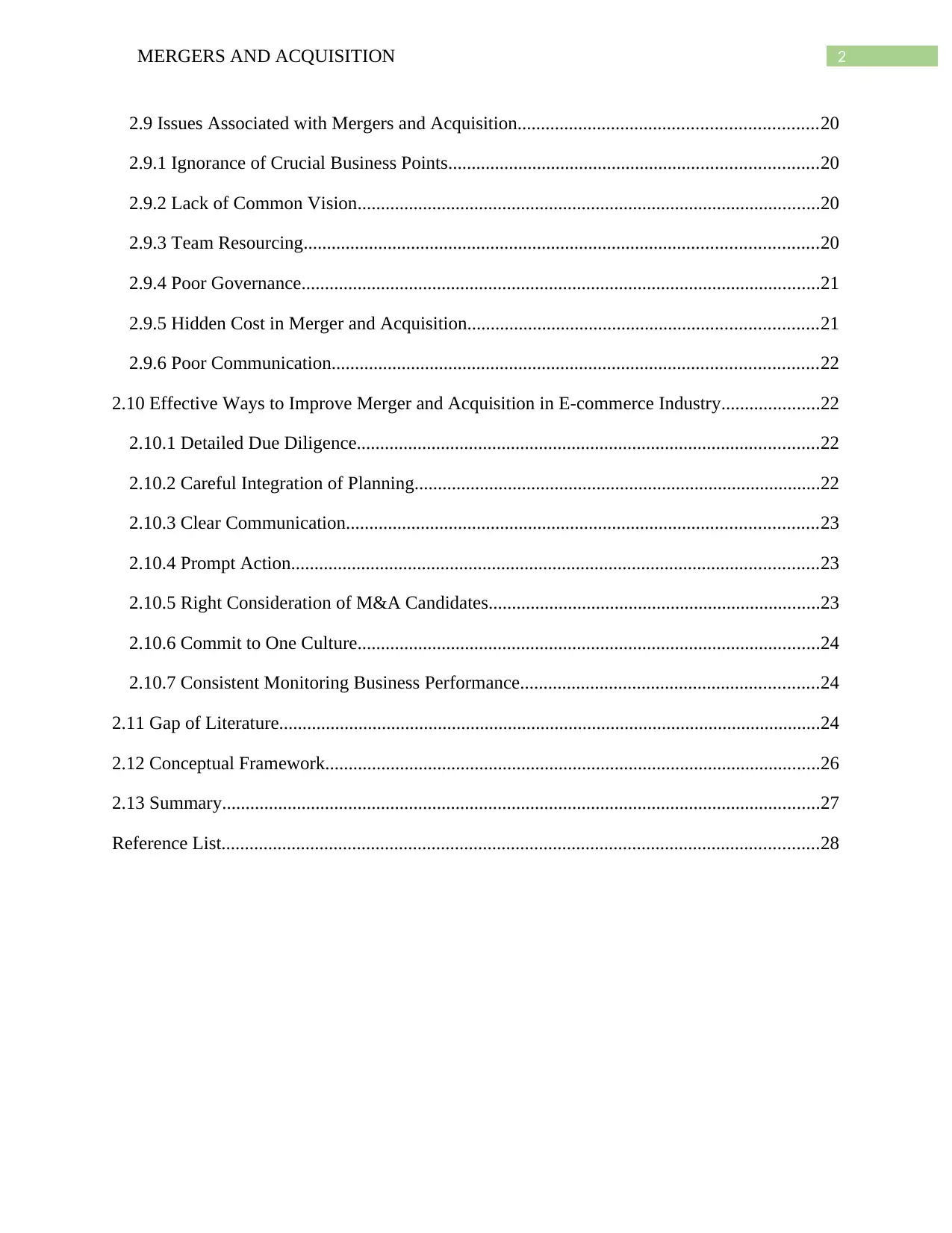
2MERGERS AND ACQUISITION
2.9 Issues Associated with Mergers and Acquisition................................................................20
2.9.1 Ignorance of Crucial Business Points...............................................................................20
2.9.2 Lack of Common Vision...................................................................................................20
2.9.3 Team Resourcing..............................................................................................................20
2.9.4 Poor Governance...............................................................................................................21
2.9.5 Hidden Cost in Merger and Acquisition...........................................................................21
2.9.6 Poor Communication........................................................................................................22
2.10 Effective Ways to Improve Merger and Acquisition in E-commerce Industry.....................22
2.10.1 Detailed Due Diligence...................................................................................................22
2.10.2 Careful Integration of Planning.......................................................................................22
2.10.3 Clear Communication.....................................................................................................23
2.10.4 Prompt Action.................................................................................................................23
2.10.5 Right Consideration of M&A Candidates.......................................................................23
2.10.6 Commit to One Culture...................................................................................................24
2.10.7 Consistent Monitoring Business Performance................................................................24
2.11 Gap of Literature....................................................................................................................24
2.12 Conceptual Framework..........................................................................................................26
2.13 Summary................................................................................................................................27
Reference List................................................................................................................................28
2.9 Issues Associated with Mergers and Acquisition................................................................20
2.9.1 Ignorance of Crucial Business Points...............................................................................20
2.9.2 Lack of Common Vision...................................................................................................20
2.9.3 Team Resourcing..............................................................................................................20
2.9.4 Poor Governance...............................................................................................................21
2.9.5 Hidden Cost in Merger and Acquisition...........................................................................21
2.9.6 Poor Communication........................................................................................................22
2.10 Effective Ways to Improve Merger and Acquisition in E-commerce Industry.....................22
2.10.1 Detailed Due Diligence...................................................................................................22
2.10.2 Careful Integration of Planning.......................................................................................22
2.10.3 Clear Communication.....................................................................................................23
2.10.4 Prompt Action.................................................................................................................23
2.10.5 Right Consideration of M&A Candidates.......................................................................23
2.10.6 Commit to One Culture...................................................................................................24
2.10.7 Consistent Monitoring Business Performance................................................................24
2.11 Gap of Literature....................................................................................................................24
2.12 Conceptual Framework..........................................................................................................26
2.13 Summary................................................................................................................................27
Reference List................................................................................................................................28
⊘ This is a preview!⊘
Do you want full access?
Subscribe today to unlock all pages.

Trusted by 1+ million students worldwide
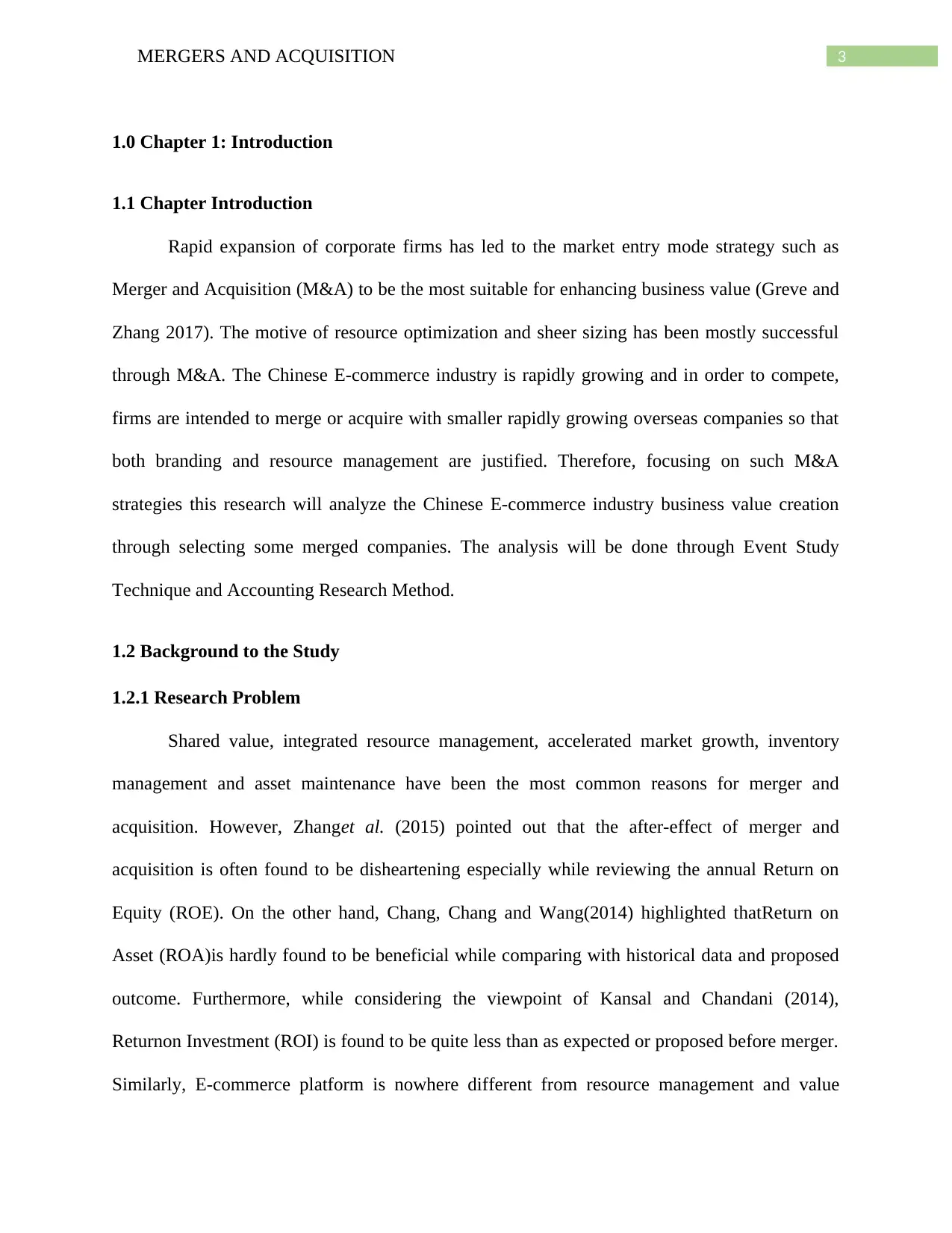
3MERGERS AND ACQUISITION
1.0 Chapter 1: Introduction
1.1 Chapter Introduction
Rapid expansion of corporate firms has led to the market entry mode strategy such as
Merger and Acquisition (M&A) to be the most suitable for enhancing business value (Greve and
Zhang 2017). The motive of resource optimization and sheer sizing has been mostly successful
through M&A. The Chinese E-commerce industry is rapidly growing and in order to compete,
firms are intended to merge or acquire with smaller rapidly growing overseas companies so that
both branding and resource management are justified. Therefore, focusing on such M&A
strategies this research will analyze the Chinese E-commerce industry business value creation
through selecting some merged companies. The analysis will be done through Event Study
Technique and Accounting Research Method.
1.2 Background to the Study
1.2.1 Research Problem
Shared value, integrated resource management, accelerated market growth, inventory
management and asset maintenance have been the most common reasons for merger and
acquisition. However, Zhanget al. (2015) pointed out that the after-effect of merger and
acquisition is often found to be disheartening especially while reviewing the annual Return on
Equity (ROE). On the other hand, Chang, Chang and Wang(2014) highlighted thatReturn on
Asset (ROA)is hardly found to be beneficial while comparing with historical data and proposed
outcome. Furthermore, while considering the viewpoint of Kansal and Chandani (2014),
Returnon Investment (ROI) is found to be quite less than as expected or proposed before merger.
Similarly, E-commerce platform is nowhere different from resource management and value
1.0 Chapter 1: Introduction
1.1 Chapter Introduction
Rapid expansion of corporate firms has led to the market entry mode strategy such as
Merger and Acquisition (M&A) to be the most suitable for enhancing business value (Greve and
Zhang 2017). The motive of resource optimization and sheer sizing has been mostly successful
through M&A. The Chinese E-commerce industry is rapidly growing and in order to compete,
firms are intended to merge or acquire with smaller rapidly growing overseas companies so that
both branding and resource management are justified. Therefore, focusing on such M&A
strategies this research will analyze the Chinese E-commerce industry business value creation
through selecting some merged companies. The analysis will be done through Event Study
Technique and Accounting Research Method.
1.2 Background to the Study
1.2.1 Research Problem
Shared value, integrated resource management, accelerated market growth, inventory
management and asset maintenance have been the most common reasons for merger and
acquisition. However, Zhanget al. (2015) pointed out that the after-effect of merger and
acquisition is often found to be disheartening especially while reviewing the annual Return on
Equity (ROE). On the other hand, Chang, Chang and Wang(2014) highlighted thatReturn on
Asset (ROA)is hardly found to be beneficial while comparing with historical data and proposed
outcome. Furthermore, while considering the viewpoint of Kansal and Chandani (2014),
Returnon Investment (ROI) is found to be quite less than as expected or proposed before merger.
Similarly, E-commerce platform is nowhere different from resource management and value
Paraphrase This Document
Need a fresh take? Get an instant paraphrase of this document with our AI Paraphraser
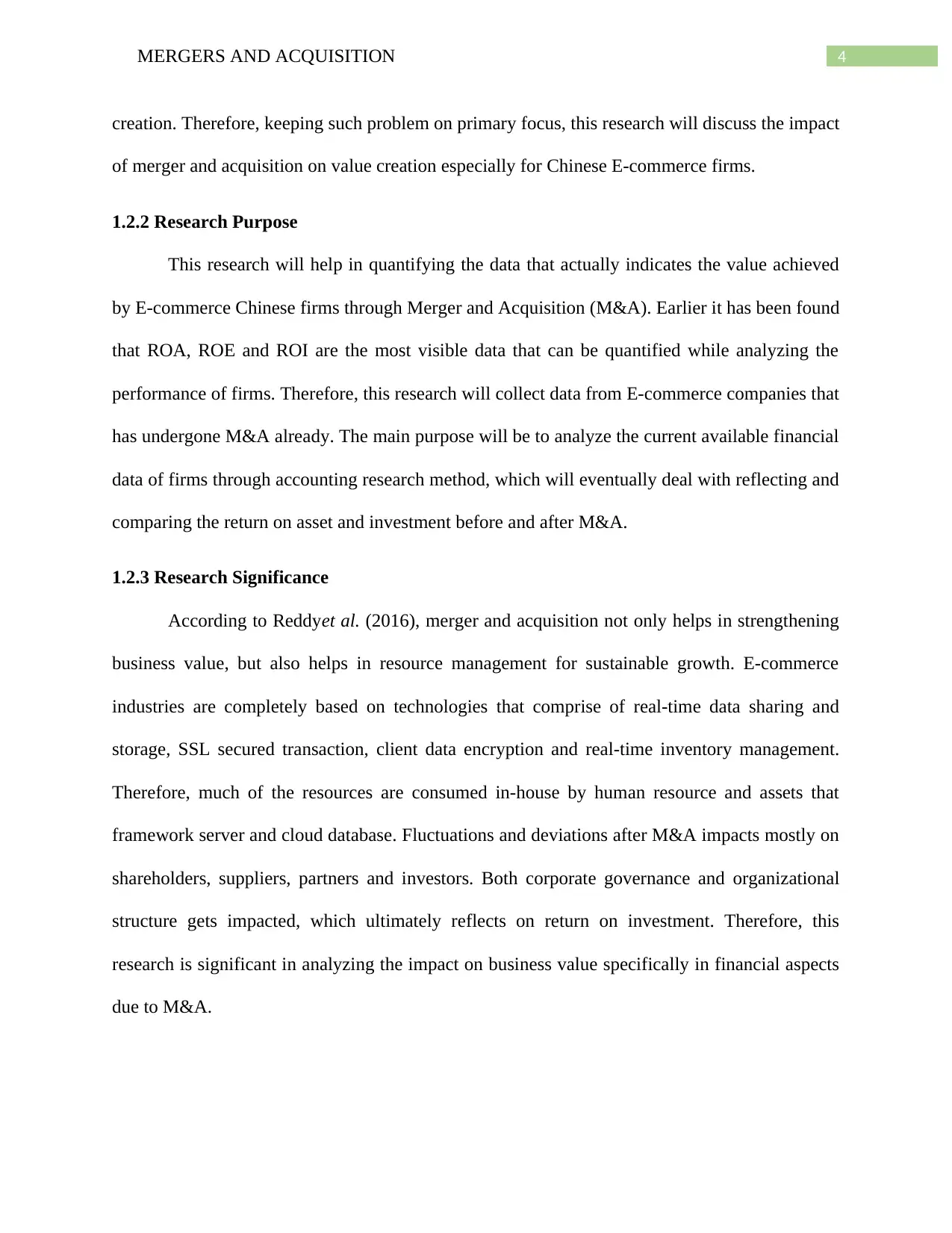
4MERGERS AND ACQUISITION
creation. Therefore, keeping such problem on primary focus, this research will discuss the impact
of merger and acquisition on value creation especially for Chinese E-commerce firms.
1.2.2 Research Purpose
This research will help in quantifying the data that actually indicates the value achieved
by E-commerce Chinese firms through Merger and Acquisition (M&A). Earlier it has been found
that ROA, ROE and ROI are the most visible data that can be quantified while analyzing the
performance of firms. Therefore, this research will collect data from E-commerce companies that
has undergone M&A already. The main purpose will be to analyze the current available financial
data of firms through accounting research method, which will eventually deal with reflecting and
comparing the return on asset and investment before and after M&A.
1.2.3 Research Significance
According to Reddyet al. (2016), merger and acquisition not only helps in strengthening
business value, but also helps in resource management for sustainable growth. E-commerce
industries are completely based on technologies that comprise of real-time data sharing and
storage, SSL secured transaction, client data encryption and real-time inventory management.
Therefore, much of the resources are consumed in-house by human resource and assets that
framework server and cloud database. Fluctuations and deviations after M&A impacts mostly on
shareholders, suppliers, partners and investors. Both corporate governance and organizational
structure gets impacted, which ultimately reflects on return on investment. Therefore, this
research is significant in analyzing the impact on business value specifically in financial aspects
due to M&A.
creation. Therefore, keeping such problem on primary focus, this research will discuss the impact
of merger and acquisition on value creation especially for Chinese E-commerce firms.
1.2.2 Research Purpose
This research will help in quantifying the data that actually indicates the value achieved
by E-commerce Chinese firms through Merger and Acquisition (M&A). Earlier it has been found
that ROA, ROE and ROI are the most visible data that can be quantified while analyzing the
performance of firms. Therefore, this research will collect data from E-commerce companies that
has undergone M&A already. The main purpose will be to analyze the current available financial
data of firms through accounting research method, which will eventually deal with reflecting and
comparing the return on asset and investment before and after M&A.
1.2.3 Research Significance
According to Reddyet al. (2016), merger and acquisition not only helps in strengthening
business value, but also helps in resource management for sustainable growth. E-commerce
industries are completely based on technologies that comprise of real-time data sharing and
storage, SSL secured transaction, client data encryption and real-time inventory management.
Therefore, much of the resources are consumed in-house by human resource and assets that
framework server and cloud database. Fluctuations and deviations after M&A impacts mostly on
shareholders, suppliers, partners and investors. Both corporate governance and organizational
structure gets impacted, which ultimately reflects on return on investment. Therefore, this
research is significant in analyzing the impact on business value specifically in financial aspects
due to M&A.
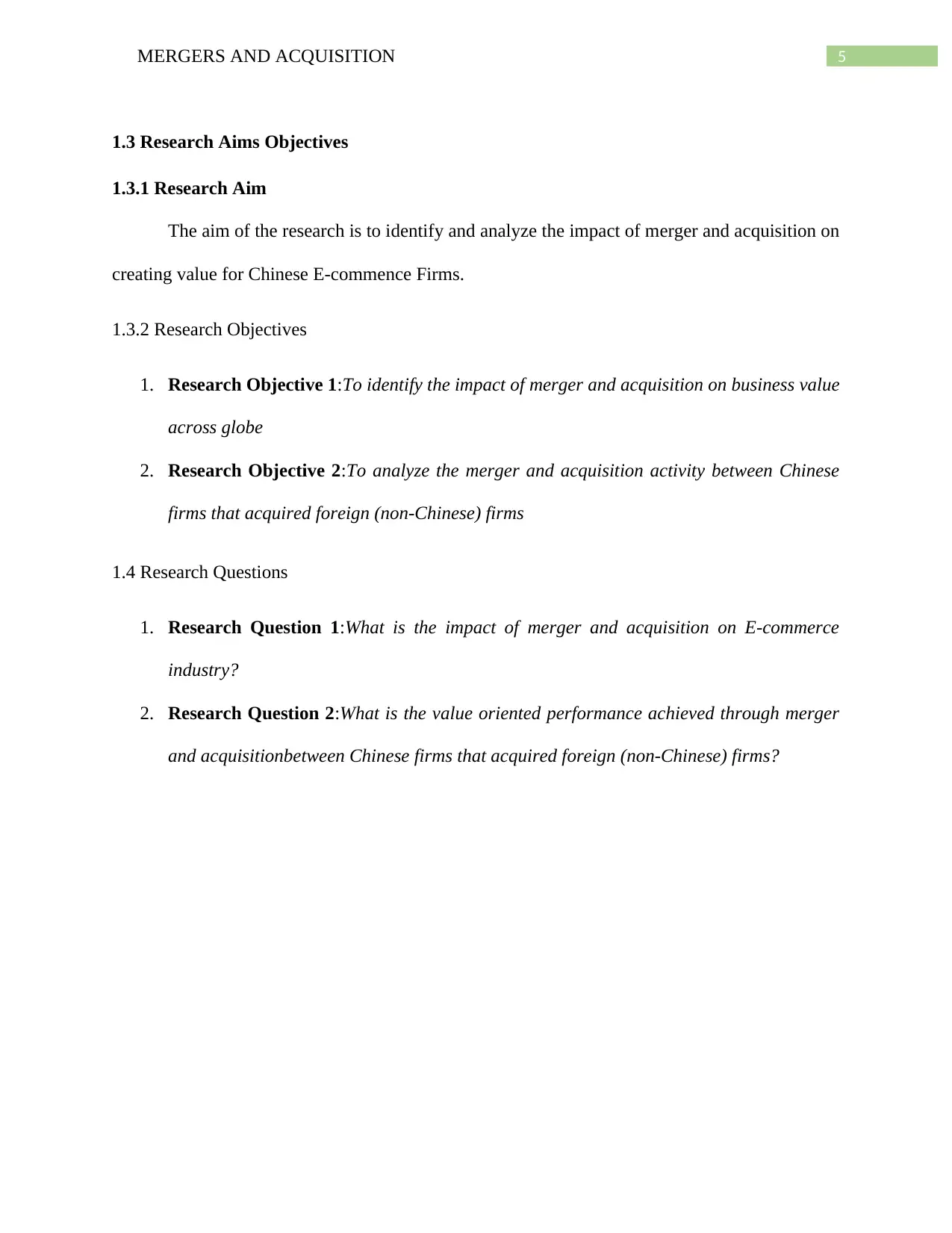
5MERGERS AND ACQUISITION
1.3 Research Aims Objectives
1.3.1 Research Aim
The aim of the research is to identify and analyze the impact of merger and acquisition on
creating value for Chinese E-commence Firms.
1.3.2 Research Objectives
1. Research Objective 1:To identify the impact of merger and acquisition on business value
across globe
2. Research Objective 2:To analyze the merger and acquisition activity between Chinese
firms that acquired foreign (non-Chinese) firms
1.4 Research Questions
1. Research Question 1:What is the impact of merger and acquisition on E-commerce
industry?
2. Research Question 2:What is the value oriented performance achieved through merger
and acquisitionbetween Chinese firms that acquired foreign (non-Chinese) firms?
1.3 Research Aims Objectives
1.3.1 Research Aim
The aim of the research is to identify and analyze the impact of merger and acquisition on
creating value for Chinese E-commence Firms.
1.3.2 Research Objectives
1. Research Objective 1:To identify the impact of merger and acquisition on business value
across globe
2. Research Objective 2:To analyze the merger and acquisition activity between Chinese
firms that acquired foreign (non-Chinese) firms
1.4 Research Questions
1. Research Question 1:What is the impact of merger and acquisition on E-commerce
industry?
2. Research Question 2:What is the value oriented performance achieved through merger
and acquisitionbetween Chinese firms that acquired foreign (non-Chinese) firms?
⊘ This is a preview!⊘
Do you want full access?
Subscribe today to unlock all pages.

Trusted by 1+ million students worldwide
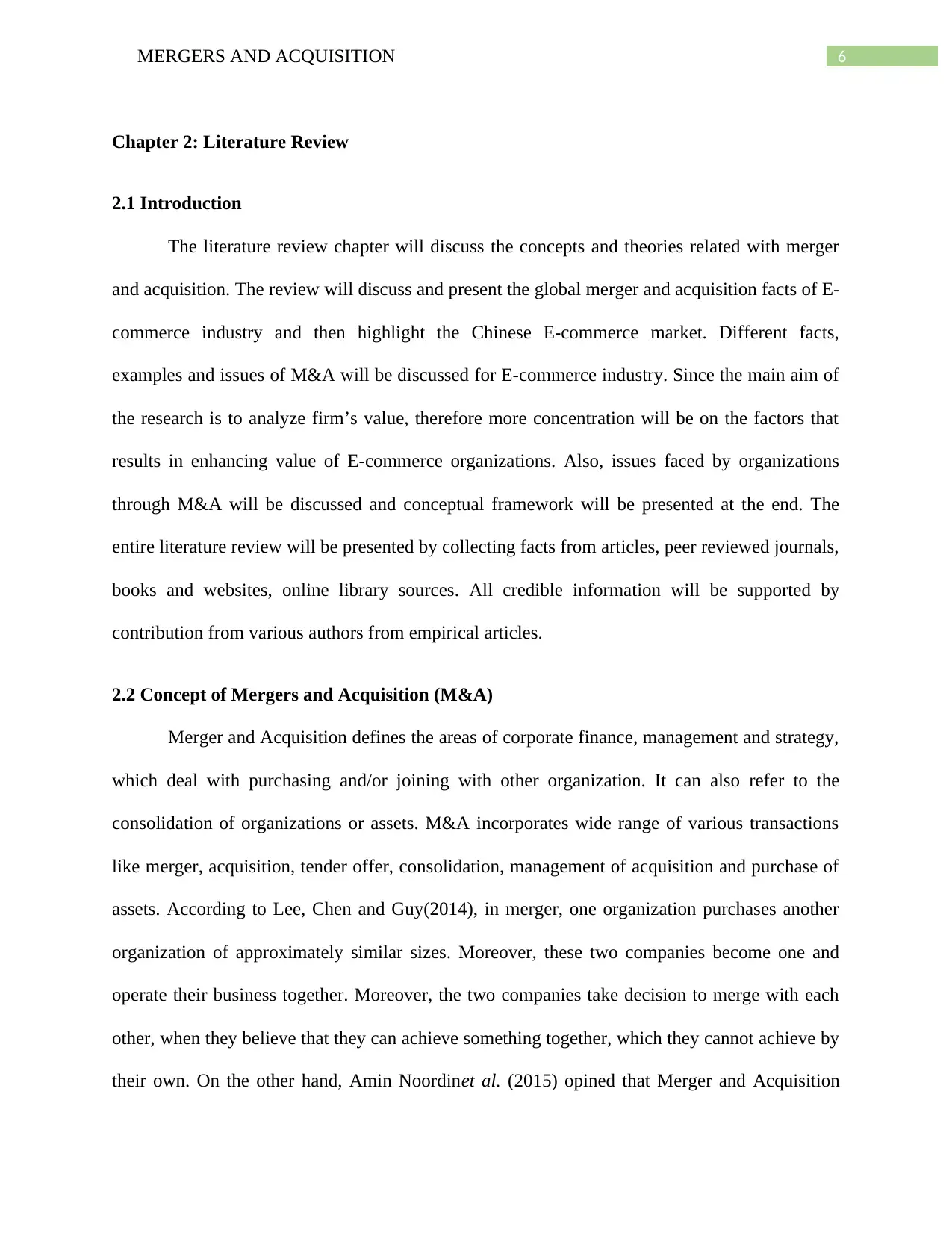
6MERGERS AND ACQUISITION
Chapter 2: Literature Review
2.1 Introduction
The literature review chapter will discuss the concepts and theories related with merger
and acquisition. The review will discuss and present the global merger and acquisition facts of E-
commerce industry and then highlight the Chinese E-commerce market. Different facts,
examples and issues of M&A will be discussed for E-commerce industry. Since the main aim of
the research is to analyze firm’s value, therefore more concentration will be on the factors that
results in enhancing value of E-commerce organizations. Also, issues faced by organizations
through M&A will be discussed and conceptual framework will be presented at the end. The
entire literature review will be presented by collecting facts from articles, peer reviewed journals,
books and websites, online library sources. All credible information will be supported by
contribution from various authors from empirical articles.
2.2 Concept of Mergers and Acquisition (M&A)
Merger and Acquisition defines the areas of corporate finance, management and strategy,
which deal with purchasing and/or joining with other organization. It can also refer to the
consolidation of organizations or assets. M&A incorporates wide range of various transactions
like merger, acquisition, tender offer, consolidation, management of acquisition and purchase of
assets. According to Lee, Chen and Guy(2014), in merger, one organization purchases another
organization of approximately similar sizes. Moreover, these two companies become one and
operate their business together. Moreover, the two companies take decision to merge with each
other, when they believe that they can achieve something together, which they cannot achieve by
their own. On the other hand, Amin Noordinet al. (2015) opined that Merger and Acquisition
Chapter 2: Literature Review
2.1 Introduction
The literature review chapter will discuss the concepts and theories related with merger
and acquisition. The review will discuss and present the global merger and acquisition facts of E-
commerce industry and then highlight the Chinese E-commerce market. Different facts,
examples and issues of M&A will be discussed for E-commerce industry. Since the main aim of
the research is to analyze firm’s value, therefore more concentration will be on the factors that
results in enhancing value of E-commerce organizations. Also, issues faced by organizations
through M&A will be discussed and conceptual framework will be presented at the end. The
entire literature review will be presented by collecting facts from articles, peer reviewed journals,
books and websites, online library sources. All credible information will be supported by
contribution from various authors from empirical articles.
2.2 Concept of Mergers and Acquisition (M&A)
Merger and Acquisition defines the areas of corporate finance, management and strategy,
which deal with purchasing and/or joining with other organization. It can also refer to the
consolidation of organizations or assets. M&A incorporates wide range of various transactions
like merger, acquisition, tender offer, consolidation, management of acquisition and purchase of
assets. According to Lee, Chen and Guy(2014), in merger, one organization purchases another
organization of approximately similar sizes. Moreover, these two companies become one and
operate their business together. Moreover, the two companies take decision to merge with each
other, when they believe that they can achieve something together, which they cannot achieve by
their own. On the other hand, Amin Noordinet al. (2015) opined that Merger and Acquisition
Paraphrase This Document
Need a fresh take? Get an instant paraphrase of this document with our AI Paraphraser
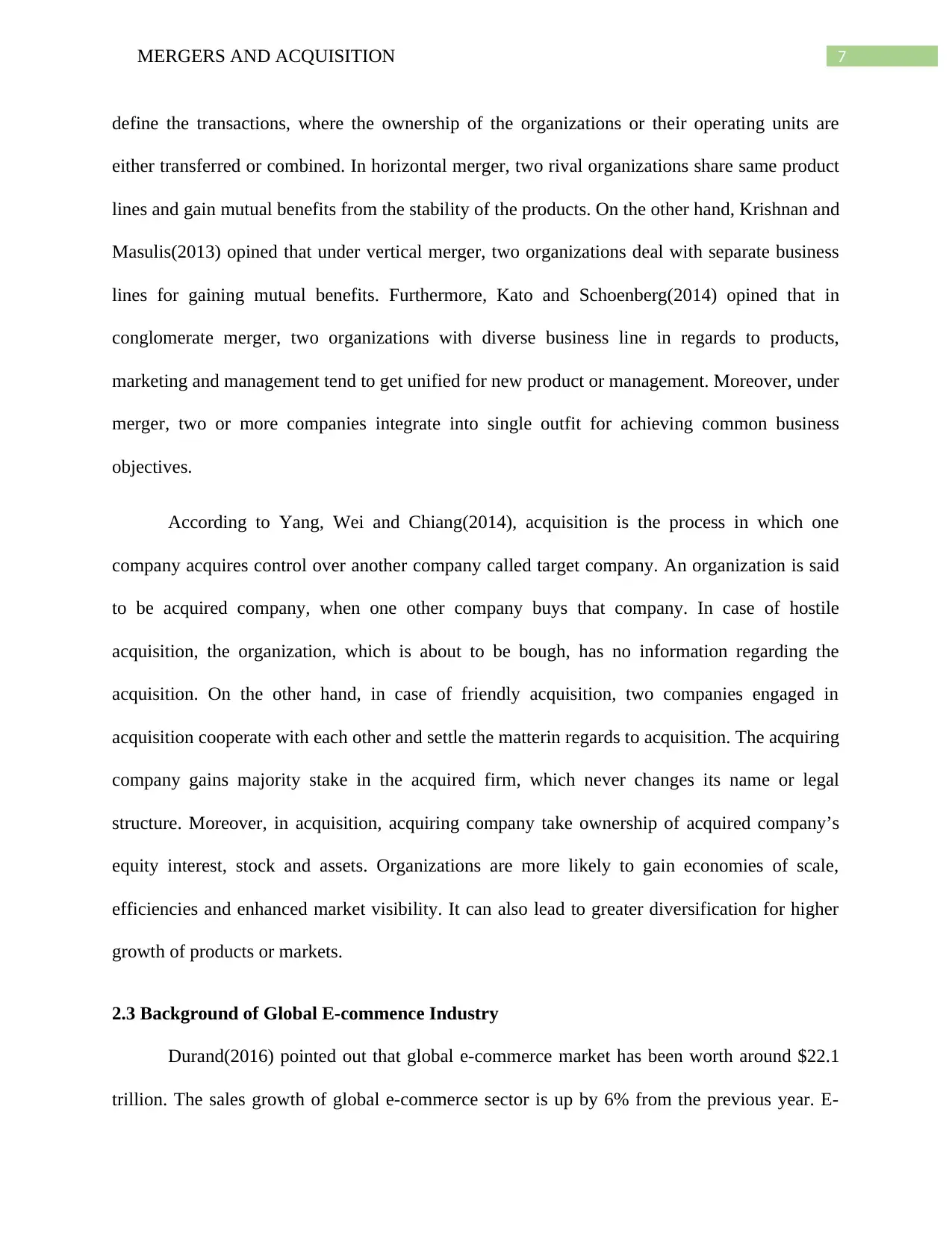
7MERGERS AND ACQUISITION
define the transactions, where the ownership of the organizations or their operating units are
either transferred or combined. In horizontal merger, two rival organizations share same product
lines and gain mutual benefits from the stability of the products. On the other hand, Krishnan and
Masulis(2013) opined that under vertical merger, two organizations deal with separate business
lines for gaining mutual benefits. Furthermore, Kato and Schoenberg(2014) opined that in
conglomerate merger, two organizations with diverse business line in regards to products,
marketing and management tend to get unified for new product or management. Moreover, under
merger, two or more companies integrate into single outfit for achieving common business
objectives.
According to Yang, Wei and Chiang(2014), acquisition is the process in which one
company acquires control over another company called target company. An organization is said
to be acquired company, when one other company buys that company. In case of hostile
acquisition, the organization, which is about to be bough, has no information regarding the
acquisition. On the other hand, in case of friendly acquisition, two companies engaged in
acquisition cooperate with each other and settle the matterin regards to acquisition. The acquiring
company gains majority stake in the acquired firm, which never changes its name or legal
structure. Moreover, in acquisition, acquiring company take ownership of acquired company’s
equity interest, stock and assets. Organizations are more likely to gain economies of scale,
efficiencies and enhanced market visibility. It can also lead to greater diversification for higher
growth of products or markets.
2.3 Background of Global E-commence Industry
Durand(2016) pointed out that global e-commerce market has been worth around $22.1
trillion. The sales growth of global e-commerce sector is up by 6% from the previous year. E-
define the transactions, where the ownership of the organizations or their operating units are
either transferred or combined. In horizontal merger, two rival organizations share same product
lines and gain mutual benefits from the stability of the products. On the other hand, Krishnan and
Masulis(2013) opined that under vertical merger, two organizations deal with separate business
lines for gaining mutual benefits. Furthermore, Kato and Schoenberg(2014) opined that in
conglomerate merger, two organizations with diverse business line in regards to products,
marketing and management tend to get unified for new product or management. Moreover, under
merger, two or more companies integrate into single outfit for achieving common business
objectives.
According to Yang, Wei and Chiang(2014), acquisition is the process in which one
company acquires control over another company called target company. An organization is said
to be acquired company, when one other company buys that company. In case of hostile
acquisition, the organization, which is about to be bough, has no information regarding the
acquisition. On the other hand, in case of friendly acquisition, two companies engaged in
acquisition cooperate with each other and settle the matterin regards to acquisition. The acquiring
company gains majority stake in the acquired firm, which never changes its name or legal
structure. Moreover, in acquisition, acquiring company take ownership of acquired company’s
equity interest, stock and assets. Organizations are more likely to gain economies of scale,
efficiencies and enhanced market visibility. It can also lead to greater diversification for higher
growth of products or markets.
2.3 Background of Global E-commence Industry
Durand(2016) pointed out that global e-commerce market has been worth around $22.1
trillion. The sales growth of global e-commerce sector is up by 6% from the previous year. E-
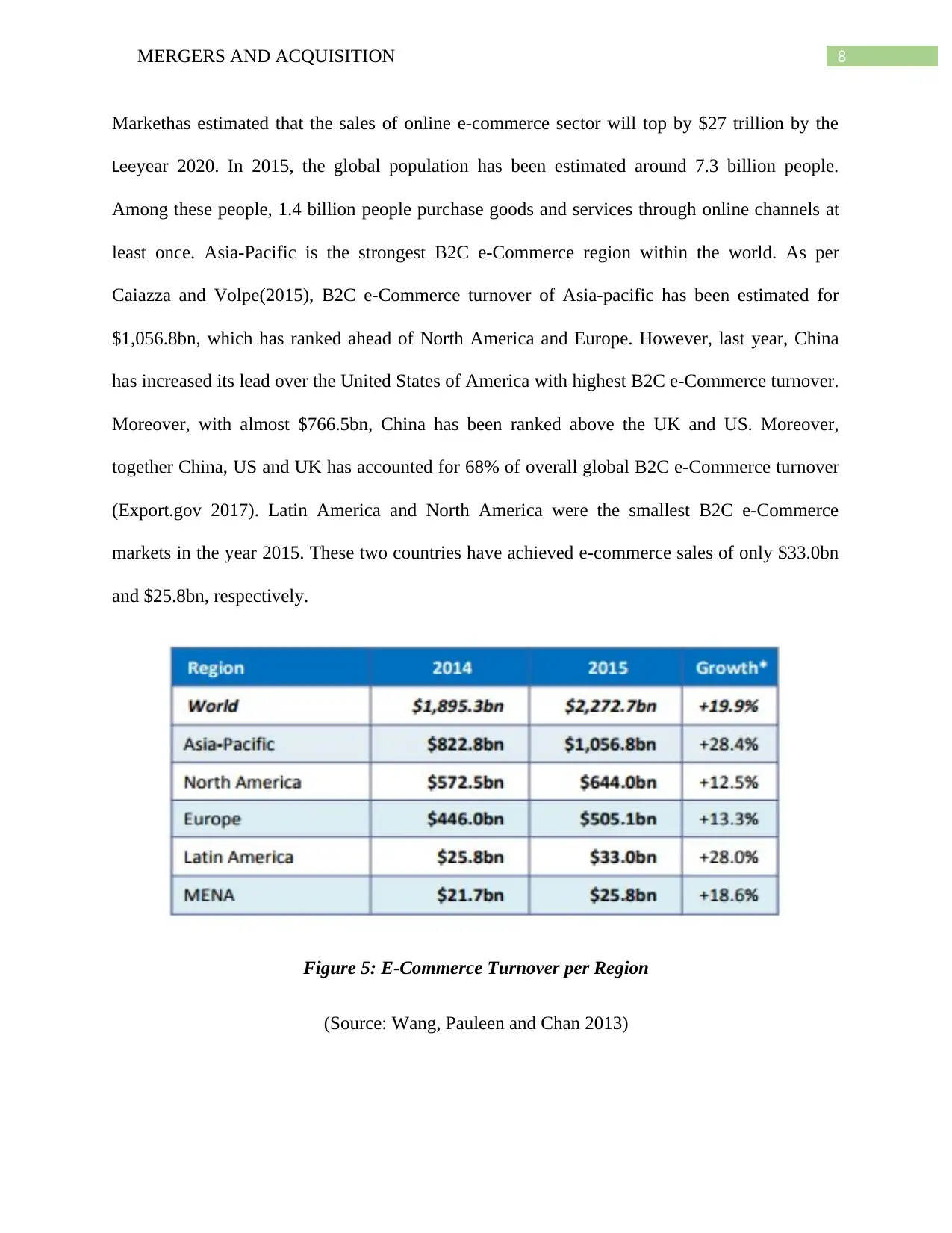
8MERGERS AND ACQUISITION
Markethas estimated that the sales of online e-commerce sector will top by $27 trillion by the
Leeyear 2020. In 2015, the global population has been estimated around 7.3 billion people.
Among these people, 1.4 billion people purchase goods and services through online channels at
least once. Asia-Pacific is the strongest B2C e-Commerce region within the world. As per
Caiazza and Volpe(2015), B2C e-Commerce turnover of Asia-pacific has been estimated for
$1,056.8bn, which has ranked ahead of North America and Europe. However, last year, China
has increased its lead over the United States of America with highest B2C e-Commerce turnover.
Moreover, with almost $766.5bn, China has been ranked above the UK and US. Moreover,
together China, US and UK has accounted for 68% of overall global B2C e-Commerce turnover
(Export.gov 2017). Latin America and North America were the smallest B2C e-Commerce
markets in the year 2015. These two countries have achieved e-commerce sales of only $33.0bn
and $25.8bn, respectively.
Figure 5: E-Commerce Turnover per Region
(Source: Wang, Pauleen and Chan 2013)
Markethas estimated that the sales of online e-commerce sector will top by $27 trillion by the
Leeyear 2020. In 2015, the global population has been estimated around 7.3 billion people.
Among these people, 1.4 billion people purchase goods and services through online channels at
least once. Asia-Pacific is the strongest B2C e-Commerce region within the world. As per
Caiazza and Volpe(2015), B2C e-Commerce turnover of Asia-pacific has been estimated for
$1,056.8bn, which has ranked ahead of North America and Europe. However, last year, China
has increased its lead over the United States of America with highest B2C e-Commerce turnover.
Moreover, with almost $766.5bn, China has been ranked above the UK and US. Moreover,
together China, US and UK has accounted for 68% of overall global B2C e-Commerce turnover
(Export.gov 2017). Latin America and North America were the smallest B2C e-Commerce
markets in the year 2015. These two countries have achieved e-commerce sales of only $33.0bn
and $25.8bn, respectively.
Figure 5: E-Commerce Turnover per Region
(Source: Wang, Pauleen and Chan 2013)
⊘ This is a preview!⊘
Do you want full access?
Subscribe today to unlock all pages.

Trusted by 1+ million students worldwide
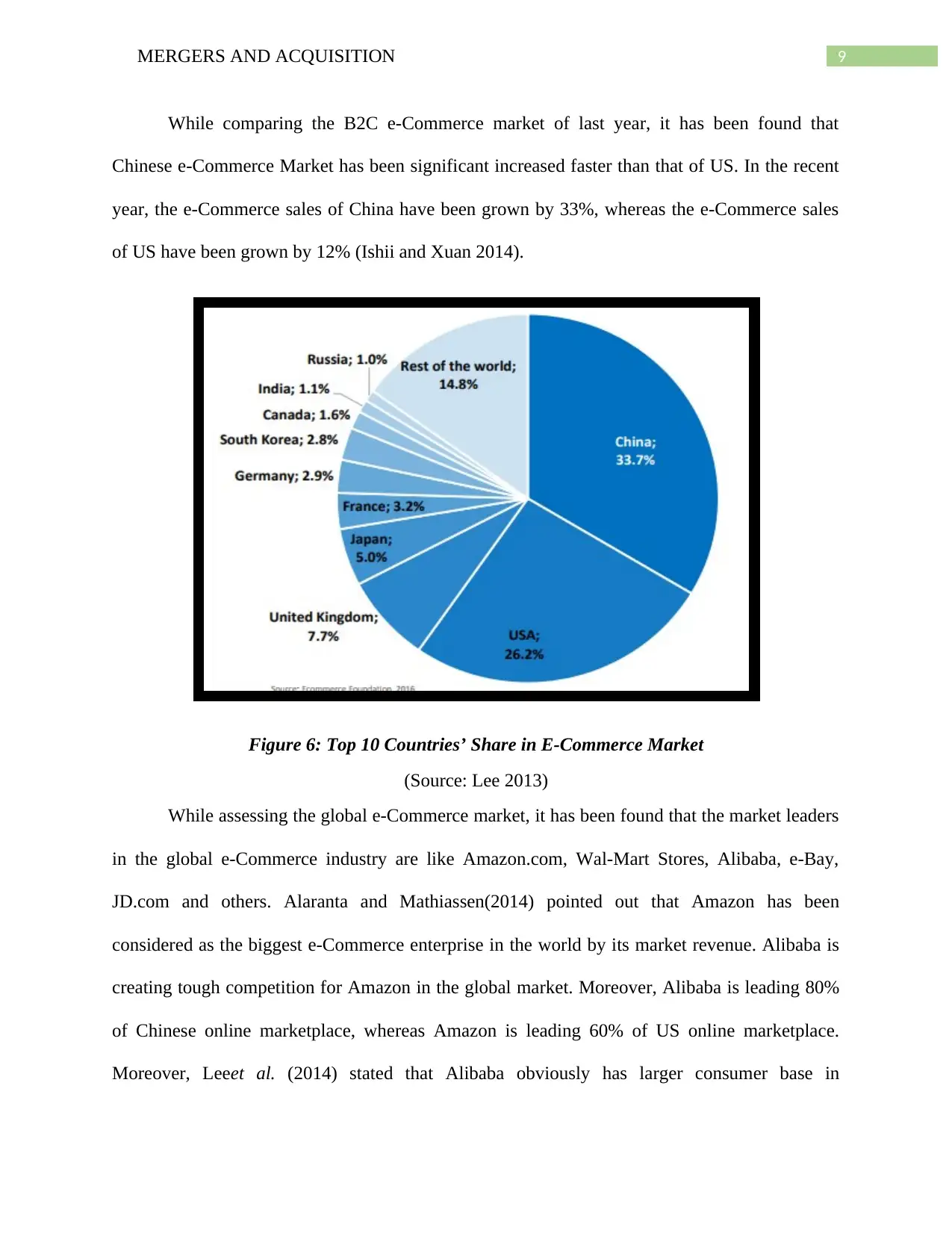
9MERGERS AND ACQUISITION
While comparing the B2C e-Commerce market of last year, it has been found that
Chinese e-Commerce Market has been significant increased faster than that of US. In the recent
year, the e-Commerce sales of China have been grown by 33%, whereas the e-Commerce sales
of US have been grown by 12% (Ishii and Xuan 2014).
Figure 6: Top 10 Countries’ Share in E-Commerce Market
(Source: Lee 2013)
While assessing the global e-Commerce market, it has been found that the market leaders
in the global e-Commerce industry are like Amazon.com, Wal-Mart Stores, Alibaba, e-Bay,
JD.com and others. Alaranta and Mathiassen(2014) pointed out that Amazon has been
considered as the biggest e-Commerce enterprise in the world by its market revenue. Alibaba is
creating tough competition for Amazon in the global market. Moreover, Alibaba is leading 80%
of Chinese online marketplace, whereas Amazon is leading 60% of US online marketplace.
Moreover, Leeet al. (2014) stated that Alibaba obviously has larger consumer base in
While comparing the B2C e-Commerce market of last year, it has been found that
Chinese e-Commerce Market has been significant increased faster than that of US. In the recent
year, the e-Commerce sales of China have been grown by 33%, whereas the e-Commerce sales
of US have been grown by 12% (Ishii and Xuan 2014).
Figure 6: Top 10 Countries’ Share in E-Commerce Market
(Source: Lee 2013)
While assessing the global e-Commerce market, it has been found that the market leaders
in the global e-Commerce industry are like Amazon.com, Wal-Mart Stores, Alibaba, e-Bay,
JD.com and others. Alaranta and Mathiassen(2014) pointed out that Amazon has been
considered as the biggest e-Commerce enterprise in the world by its market revenue. Alibaba is
creating tough competition for Amazon in the global market. Moreover, Alibaba is leading 80%
of Chinese online marketplace, whereas Amazon is leading 60% of US online marketplace.
Moreover, Leeet al. (2014) stated that Alibaba obviously has larger consumer base in
Paraphrase This Document
Need a fresh take? Get an instant paraphrase of this document with our AI Paraphraser
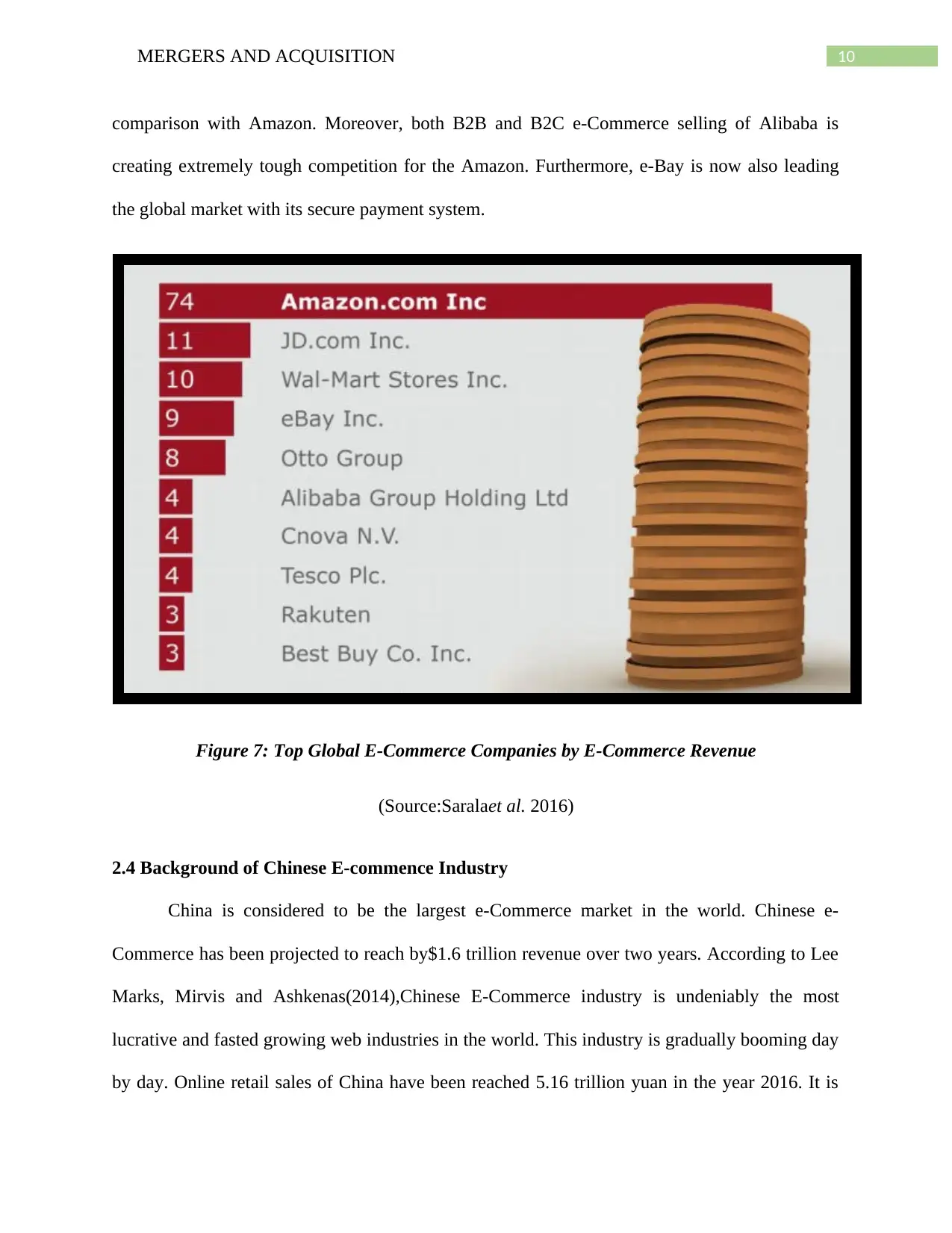
10MERGERS AND ACQUISITION
comparison with Amazon. Moreover, both B2B and B2C e-Commerce selling of Alibaba is
creating extremely tough competition for the Amazon. Furthermore, e-Bay is now also leading
the global market with its secure payment system.
Figure 7: Top Global E-Commerce Companies by E-Commerce Revenue
(Source:Saralaet al. 2016)
2.4 Background of Chinese E-commence Industry
China is considered to be the largest e-Commerce market in the world. Chinese e-
Commerce has been projected to reach by$1.6 trillion revenue over two years. According to Lee
Marks, Mirvis and Ashkenas(2014),Chinese E-Commerce industry is undeniably the most
lucrative and fasted growing web industries in the world. This industry is gradually booming day
by day. Online retail sales of China have been reached 5.16 trillion yuan in the year 2016. It is
comparison with Amazon. Moreover, both B2B and B2C e-Commerce selling of Alibaba is
creating extremely tough competition for the Amazon. Furthermore, e-Bay is now also leading
the global market with its secure payment system.
Figure 7: Top Global E-Commerce Companies by E-Commerce Revenue
(Source:Saralaet al. 2016)
2.4 Background of Chinese E-commence Industry
China is considered to be the largest e-Commerce market in the world. Chinese e-
Commerce has been projected to reach by$1.6 trillion revenue over two years. According to Lee
Marks, Mirvis and Ashkenas(2014),Chinese E-Commerce industry is undeniably the most
lucrative and fasted growing web industries in the world. This industry is gradually booming day
by day. Online retail sales of China have been reached 5.16 trillion yuan in the year 2016. It is
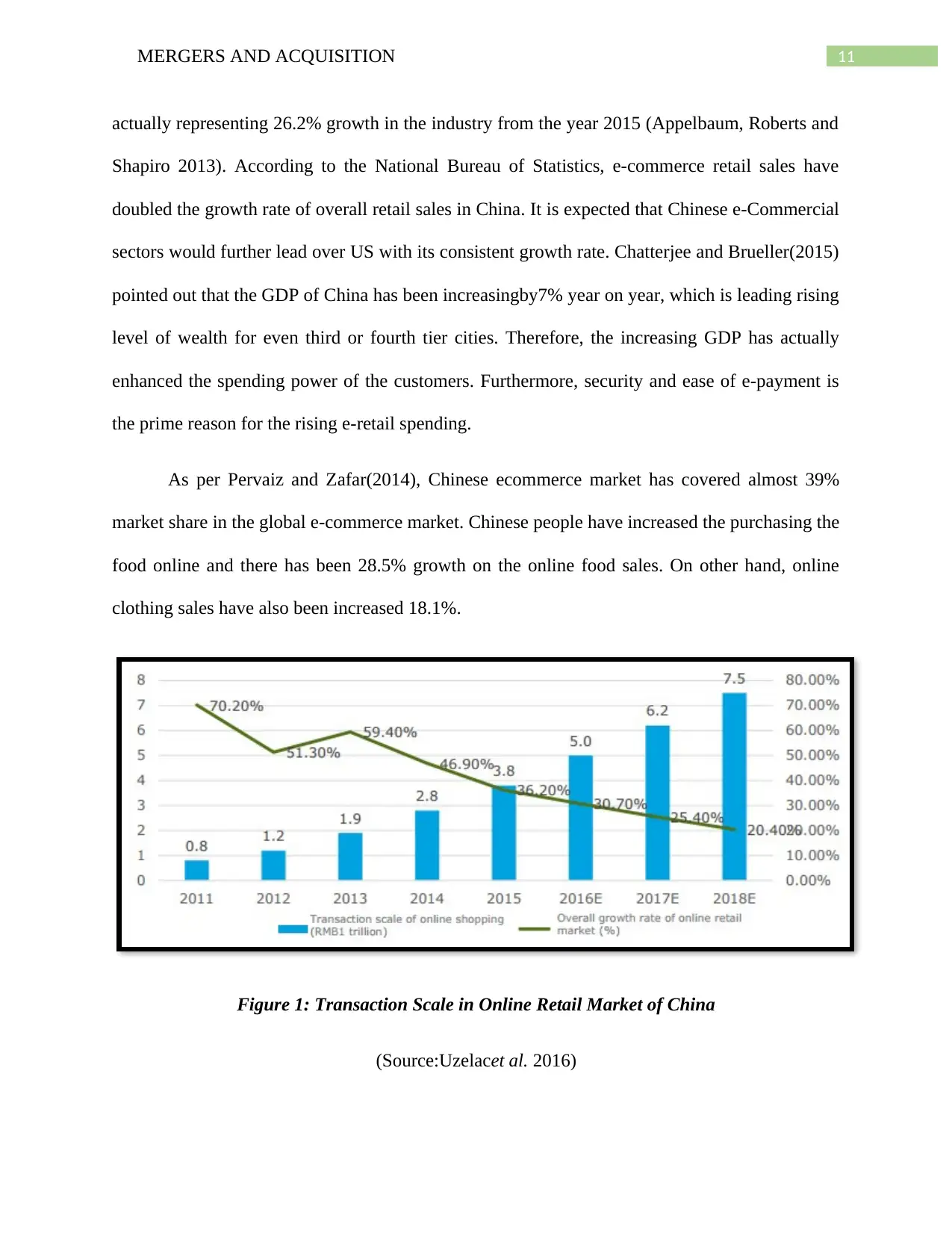
11MERGERS AND ACQUISITION
actually representing 26.2% growth in the industry from the year 2015 (Appelbaum, Roberts and
Shapiro 2013). According to the National Bureau of Statistics, e-commerce retail sales have
doubled the growth rate of overall retail sales in China. It is expected that Chinese e-Commercial
sectors would further lead over US with its consistent growth rate. Chatterjee and Brueller(2015)
pointed out that the GDP of China has been increasingby7% year on year, which is leading rising
level of wealth for even third or fourth tier cities. Therefore, the increasing GDP has actually
enhanced the spending power of the customers. Furthermore, security and ease of e-payment is
the prime reason for the rising e-retail spending.
As per Pervaiz and Zafar(2014), Chinese ecommerce market has covered almost 39%
market share in the global e-commerce market. Chinese people have increased the purchasing the
food online and there has been 28.5% growth on the online food sales. On other hand, online
clothing sales have also been increased 18.1%.
Figure 1: Transaction Scale in Online Retail Market of China
(Source:Uzelacet al. 2016)
actually representing 26.2% growth in the industry from the year 2015 (Appelbaum, Roberts and
Shapiro 2013). According to the National Bureau of Statistics, e-commerce retail sales have
doubled the growth rate of overall retail sales in China. It is expected that Chinese e-Commercial
sectors would further lead over US with its consistent growth rate. Chatterjee and Brueller(2015)
pointed out that the GDP of China has been increasingby7% year on year, which is leading rising
level of wealth for even third or fourth tier cities. Therefore, the increasing GDP has actually
enhanced the spending power of the customers. Furthermore, security and ease of e-payment is
the prime reason for the rising e-retail spending.
As per Pervaiz and Zafar(2014), Chinese ecommerce market has covered almost 39%
market share in the global e-commerce market. Chinese people have increased the purchasing the
food online and there has been 28.5% growth on the online food sales. On other hand, online
clothing sales have also been increased 18.1%.
Figure 1: Transaction Scale in Online Retail Market of China
(Source:Uzelacet al. 2016)
⊘ This is a preview!⊘
Do you want full access?
Subscribe today to unlock all pages.

Trusted by 1+ million students worldwide
1 out of 33
Related Documents
Your All-in-One AI-Powered Toolkit for Academic Success.
+13062052269
info@desklib.com
Available 24*7 on WhatsApp / Email
![[object Object]](/_next/static/media/star-bottom.7253800d.svg)
Unlock your academic potential
Copyright © 2020–2025 A2Z Services. All Rights Reserved. Developed and managed by ZUCOL.





